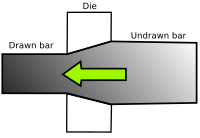
Photo from wikipedia
Abstract Current challenges in the automotive industry are the reduction of fuel consumption and the CO2 emissions of future car generations. These aims can be achieved by reducing the weight… Click to show full abstract
Abstract Current challenges in the automotive industry are the reduction of fuel consumption and the CO2 emissions of future car generations. These aims can be achieved by reducing the weight of the car, which further improves the driving dynamics. In most currently mass-produced cars, the body accounts for one of the largest parts by weight, and hence designing a lightweight car body assumes great importance for reducing fuel consumption and CO2 emissions. Extremely lightweight designs can be achieved by using purely composite materials, which are very light but also highly cost intensive and not yet suitable for large scale production due to the necessity of manual processing. A promising approach for the automated, large-scale production of lightweight car structures with a high stiffness to weight ratio is the combination of high strength steel alloys and CFRP prepregs in a special hybrid material/fiber metal laminate (FML) – which can be further processed by forming technologies such as deep drawing. In current research work at the Chair of Forming and Machining Technology (LUF) at the University of Paderborn, innovative manufacturing processes are being developed for the production of high strength automotive structural components made of fiber metal laminates. This paper presents the results of technological and numerical research that is currently being performed at the LUF into the forming of hybrid fiber metal laminates. This paper focuses on the results of basic research and the individual measures (tool, process and material design) necessary for achieving the desired part quality.
Journal Title: Composite Structures
Year Published: 2019
Link to full text (if available)
Share on Social Media: Sign Up to like & get
recommendations!